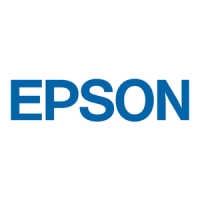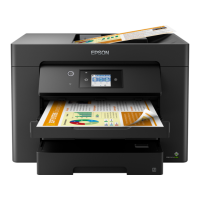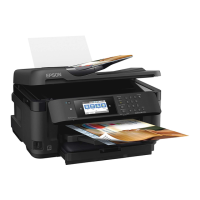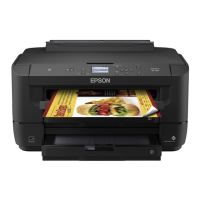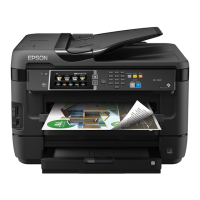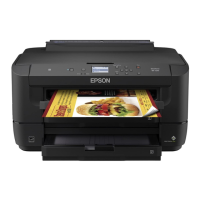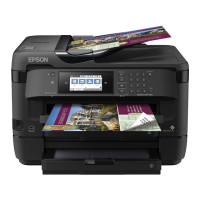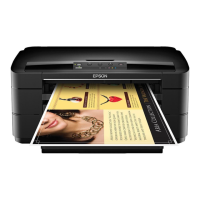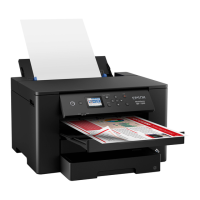Do you have a question about the Epson WF-7840 Series and is the answer not in the manual?
| Print Resolution | 4800 x 2400 dpi |
|---|---|
| Max Print Size | 13" x 19" |
| Duplex Printing | Yes |
| Scanner Type | Flatbed, ADF |
| Scan Resolution | 1200 x 2400 dpi |
| Connectivity | USB, Ethernet, Wi-Fi, Wi-Fi Direct |
| Display | 4.3" Color Touchscreen |
| Category | Printer |
| Functions | Print, Copy, Scan, Fax |
| Maximum Paper Size | 13" x 19" |
| Input Paper Capacity | 250 sheets |
| ADF Capacity | 50 sheets |
| Print Technology | PrecisionCore |
| Print Speed Black | 25 ppm |
| Print Speed Color | 12 ppm |
| Paper Capacity | 250 sheets |
| Printing Technology | PrecisionCore |
| Mobile Printing | Apple AirPrint, Mopria Print Service, Epson Connect |
| Paper Sizes | A4, A5, Letter, Legal |
| Paper Capacity Maximum | 500 sheets |
| Monthly Duty Cycle | 50, 000 pages |
| Product Type | All-in-One Printer |
Outlines the various manuals supplied with the printer and how to obtain them.
Explains how to search for information within the PDF manual using keywords or bookmarks.
Describes how to extract and print specific pages from the manual.
Explains the meaning of marks and symbols, notes on descriptions, and OS references used in the manual.
Lists trademarks and registered trademarks of various companies mentioned in the manual.
States the copyright information and restrictions on reproduction and liability.
Provides essential instructions for the safe use of the printer.
Details advisories and warnings to prevent damage to the printer or property.
Specific warnings and precautions related to setting up the printer.
General advisories and warnings for operating the printer.
Precautions and advice for using the printer's touchscreen interface.
Warnings related to potential interference with medical equipment and automatic devices due to radio waves.
Instructions and warnings for safely transporting or storing the printer.
Guidance on how to erase personal information stored in the printer's memory before disposal.
Identifies and describes the external parts of the printer's front panel and ADF.
Identifies and describes the internal components accessible from the inside of the printer.
Identifies and describes the ports and connections on the rear of the printer.
Overview of the printer's control panel buttons and their functions.
Explains the icons and options available on the printer's home screen.
Details how to navigate and configure settings within the printer's menu screens.
Explains how to check the status of ongoing jobs and the job history.
Describes how to use the on-screen keyboard for entering characters and symbols.
Explains how to view operating instruction animations on the LCD screen.
Provides essential precautions for handling paper to prevent jams and ensure print quality.
Explains how to register and manage paper size and type settings for optimal printing.
General instructions and guidance for loading paper into the printer.
Specific instructions for loading pre-punched paper, noting limitations.
Guidance on loading and handling long paper types, with specific considerations.
Lists types of originals that should not be fed into the ADF and should instead be scanned on the glass.
Explains how the printer automatically identifies original sizes when using the ADF.
Instructions on how to place originals on the scanner glass or in the ADF.
Instructions on how to insert a USB device into the printer's external interface USB port.
Guidance on safely removing a USB device to prevent data loss.
Explains how to write or read data on a memory device connected to the printer.
Comprehensive guide to printing documents from a computer, covering Windows and Mac OS.
Instructions for printing on envelopes from both Windows and Mac OS.
Details on printing JPEG and TIFF files from a memory device.
Instructions for printing web pages from a computer or smart device.
Information on printing via Epson Connect services using the internet.
Outlines the different methods available for copying originals.
Basic steps for copying originals by size or color/monochrome.
Instructions for performing double-sided copying of originals.
Steps for copying originals at a specified magnification.
How to copy multiple originals onto a single sheet of paper.
Procedure for discharging copies one at a time in page order for multi-page documents.
Methods for copying originals without shadows and punched holes.
Instructions for scanning and copying both sides of an ID card onto one side of paper.
How to copy two facing pages of a book onto separate sheets.
Explanation of fundamental settings for copying, such as Color Mode and Density.
Details advanced settings for copying, including Multi-Page and Image Quality.
Lists the various methods available for scanning documents using the printer.
Steps for scanning documents and saving them to a network folder.
Procedure for scanning documents and sending them directly via email.
Instructions for scanning documents and saving them to a connected computer.
Steps for scanning documents directly to a memory device inserted into the printer.
How to send scanned images to cloud services via Epson Connect.
Instructions for scanning to a computer using the WSD feature.
Guidance on scanning images directly to a smart device using the Epson Smart Panel app.
Checks and prerequisites before using the printer's fax capabilities.
Introduces the printer's fax functionalities, including sending and receiving methods.
Details the methods and features related to sending faxes.
Explains the different modes and options for receiving faxes.
Instructions for sending and receiving faxes directly from a computer.
Information on checking the status of sent and received faxes through reports.
How to check the progress and history of fax jobs.
Describes the fax box features like Inbox, Stored Documents, and Polling Send/Board.
Security features to prevent errors and information leakage during fax operations.
Includes features like blocking junk faxes.
Step-by-step guide to sending faxes directly from the printer's control panel.
Methods for specifying fax recipients manually, from contacts, or history.
How the printer receives faxes and manages them.
Details on using manual receive mode for faxing and phone calls.
Explains how the printer automatically receives faxes based on call type.
How to receive faxes from another machine by dialing.
Options for saving or forwarding received faxes to various destinations.
How to view received faxes directly on the printer's screen.
Overview of menu options available for faxing.
Settings for specifying fax recipients.
Configuration options for fax transmission settings.
Access to additional fax features like Transmission Log and Fax Reports.
Options for managing the Fax Box, including Inbox/Confidential and Stored Documents.
Details on managing received faxes in the Inbox and confidential boxes.
Information on storing and managing documents for later faxing.
Features for sending faxes on demand using polling or bulletin board boxes.
How to check the status and history of fax jobs.
Detailed steps for sending faxes from a computer using Windows or Mac OS applications.
How to receive faxes directly on a computer using the FAX Utility.
How to check ink levels and maintenance box status from the control panel.
Procedures for adjusting settings to enhance overall print quality.
Steps to improve print quality by adjusting settings and performing checks.
Guidance on diagnosing and cleaning clogged print head nozzles.
Instructions on cleaning the printer's paper path to remove ink smears.
How to clean the scanner glass and document mat for optimal scanning.
Steps for cleaning the Automatic Document Feeder (ADF) rollers and interior.
Instructions for cleaning the printer's outer case.
How to configure printer settings to reduce power consumption.
Procedures for installing or removing printer-related software applications.
Guidance on updating software and firmware for improved performance.
Steps for properly packing and storing the printer for transport or storage.
Comprehensive troubleshooting for various printer operational issues.
Solutions for issues related to paper feeding, including jams and misfeeds.
Troubleshooting steps for issues preventing printing from Windows or Mac OS.
Solutions for network connectivity problems, including Wi-Fi issues.
Troubleshooting steps for issues preventing the start of scanning operations.
Solutions for errors encountered when saving scanned images to a shared folder.
Troubleshooting for issues related to sending and receiving faxes.
Explains how to interpret and resolve error codes displayed on the printer.
Step-by-step instructions on how to remove jammed paper.
Information and procedures for replacing ink cartridges.
Important safety and handling instructions for ink cartridges.
Options for continuing to print temporarily with limited ink.
Guidance on when and how to replace the printer's maintenance box.
Troubleshooting steps for poor quality output across all printer functions.
Specific solutions for issues affecting print quality, such as banding or color problems.
Troubleshooting steps for issues affecting copy quality, such as alignment or smearing.
Solutions for issues related to scanned image quality, such as dirt or incorrect area.
Troubleshooting steps for poor image quality when sending faxes.
Solutions for poor quality of received faxes.
General advice and contact information if other solutions fail.
Specific troubleshooting steps for persistent printing or copying issues.
How to connect a computer or smart device to an already networked printer.
Steps to reconfigure network settings, such as when replacing a router.
Instructions for connecting smart devices directly to the printer via Wi-Fi Direct.
Specific steps for connecting iOS devices using Wi-Fi Direct.
Specific steps for connecting Android devices using Wi-Fi Direct.
How to connect other types of devices using Wi-Fi Direct.
How to check the printer's network connection status and signal strength.
Details on available paper types and their loading capacities in different paper sources.
Lists compatible paper types and their specifications for loading.
Lists paper types that should not be used to avoid jams and smears.
Information on ink cartridge codes and handling precautions.
Lists the codes for genuine Epson ink cartridges by region.
Introduces available software products for the printer from Epson.
Details on applications and drivers for printing from a computer.
Information on applications for configuring fax operations.
Details on applications for scanning documents from a computer.
Information on EpsonNet SetupManager for creating driver packages.
Details on applications for configuring printer settings and managing devices.
Instructions for using Web Config to configure printer settings via a web browser.
An overview of the printer's settings menu structure.
Explains the various settings available under the General Settings menu.
Details on basic settings like LCD Brightness, Sounds, and Sleep Timer.
Options for configuring paper sources, tray priority, and other print-related settings.
How to set up and manage Wi-Fi and wired network connections.
Step-by-step guide to configuring Wi-Fi network settings.
Information on connecting directly to the printer using Wi-Fi Direct.
Settings for Epson Connect services and other web services.
Comprehensive guide to configuring all fax-related settings.
How to configure shortcuts for frequently used fax functions.
Core settings for faxing, including Fax Speed, ECM, and Dial Tone.
Options for configuring fax sending behavior, such as Auto Rotation and Batch Send.
Settings for how the printer handles received faxes, including saving and forwarding.
Options for saving and forwarding received faxes to various destinations.
How to save or forward faxes without specific conditions.
Setting up save/forward rules based on specific conditions.
General settings related to saving and forwarding faxes, including Inbox options.
Options for printing various fax reports like Transmission Reports and Fax Logs.
Settings to enhance printer security, including password protection and restrictions.
How to restrict manual fax number entry.
Limits on the number of recipients for broadcasting.
Displaying a confirmation screen before transmission.
Automatically clearing backup data after successful operations.
Procedure to check the printer's connection to the phone line for faxing.
A wizard to configure basic fax settings.
Tools for managing the printer as a system administrator, including user restrictions.
Managing contact information for fax, email, and network scanning destinations.
Changing default settings for scanning, copying, and faxing functions.
Technical details and specifications of the printer.
Details about print head, paper weight, and ink nozzles.
Information on the printable area for single sheets and envelopes.
Technical details about the printer's scanner capabilities.
Specifications related to the Automatic Document Feeder.
Technical details about the printer's fax capabilities.
Information on ports used by the printer for network communication.
Details about the printer's network capabilities, including Wi-Fi and Ethernet.
Technical standards and specifications for Wi-Fi connectivity.
Technical details regarding Ethernet connectivity.
Supported network printing and scanning functions with protocols.
Details on USB interface specifications.
Information on the capacities and limitations of memory devices.
Lists third-party services supported by the printer, like AirPrint.
Information on power supply requirements and rated current.
Operating and storage conditions for the printer.
Storage and freezing temperature guidelines for ink cartridges.
Recommended dimensions for printer installation and operation.
Lists the operating systems supported by the printer.
Information related to standards and approvals for the printer.
Details on safety, EMC, and other standards compliance.
Legal and responsible use restrictions for copying various items.
Guides on connecting the printer to a network via Ethernet or Wi-Fi.
Information needed before establishing a network connection.
Details on gathering necessary network setting information.
Explains static and dynamic (DHCP) IP address assignment methods.
Configuration of DNS and proxy server settings for internet access.
Step-by-step instructions to connect the printer to the network using its control panel.
Procedure for setting a static IP address for the printer.
How to configure proxy server settings for internet access.
Instructions for connecting the printer to a network via Ethernet or Wi-Fi.
Steps for connecting the printer using an Ethernet cable.
Guides on connecting the printer to a wireless LAN using various methods.
Options and settings for utilizing the printer's functions.
How to enable and use print functions through the network.
Explains peer-to-peer and server/client connection methods.
Configuration for direct printer-to-computer network connections.
Settings for printer sharing via a server computer.
Steps to create print queues and set network ports for network printing.
How to set paper size, type, and source settings via Web Config.
Configuring how the printer handles paper size and type errors.
Instructions for setting up AirPrint for printing from Apple devices.
Steps to configure email server settings for scanning to email.
Details on settings for SMTP, POP, and secure connections.
How to test the connection to the mail server.
Lists messages and causes for mail server connection test failures.
Registering destinations in the printer's contacts list for easy access.
How to register multiple destinations as a group using Web Config.
Steps to register contacts via Web Config.
Details on common, fax, email, and network folder settings for contacts.
How to register destinations as a group using Web Config.
Procedures for backing up and importing printer contacts.
How to save contact information to a file.
Steps to import contacts from a backup file using Web Config.
How to back up printer contact data to a computer using Web Config.
Using Epson Device Admin for contact management.
Setting up the printer to use an LDAP server for address information.
Details on LDAP server settings like search base and attributes.
Setting up search criteria for the LDAP server.
Preparations required for scanning operations.
How to perform scanning operations using the printer's control panel.
Configuration details for network folders and email servers for scanning.
Instructions for scanning documents from a computer using Epson ScanSmart or Scan 2.
How to ensure the network scan service is enabled.
Steps to set up and enable the printer's fax functionalities.
Prerequisites and checks before using fax features.
Instructions on connecting the printer to various types of phone lines.
Lists compatible and incompatible phone line types.
How to connect to standard phone lines or PBX systems.
Steps for connecting to DSL or ISDN lines.
How to connect an external phone device to the printer.
Guide to setting up the printer for sending and receiving faxes.
A wizard to configure basic fax settings.
Customizing fax features based on specific usage scenarios.
Configuring fax settings for PBX phone systems with external access codes.
Adjusting settings for using an answering machine or connected phone.
How to configure the printer to work with an answering machine.
Instructions for receiving faxes using a connected phone without printer interaction.
Configuring options to save and forward received faxes.
Steps to save received faxes to the printer's inbox or memory devices.
How to set up forwarding for received faxes to different destinations.
Setting up save/forward rules based on specific conditions.
Configuring saving rules based on sender or time.
Setting up forwarding rules based on specified conditions.
How to configure settings to block unwanted junk faxes.
Instructions for setting up fax operations from a computer using FAX Utility.
Steps to enable fax sending functionality from a computer.
Configuring the printer to save received faxes to a computer.
Setting to save faxes to a computer and print them simultaneously.
How to disable saving received faxes to a computer.
Configuring basic operational settings for the printer.
Setting up various functions and display options for the control panel.
Configuring power saving modes and automatic power off settings.
Adjusting sound settings for printer operations.
Setting up automatic date and time synchronization with a time server.
Setting default values for scanning, copying, and faxing functions.
Hints and solutions for problems encountered during setting configuration.
Troubleshooting steps for issues preventing access to Web Config.
What to do if the CA-signed certificate has expired.
Troubleshooting steps when certificate names do not match.
Overview of printer management features and security functions.
Introduces the security functions available for Epson devices.
How to set and manage the administrator password for system settings.
Limiting functions available to users based on their accounts.
Controls the interface, such as USB ports, for connecting external devices.
Configuration options for administrator settings.
Steps to set and change the administrator password.
How to lock printer settings using the administrator password.
Procedures to enable the panel lock feature.
Lists items in General Settings that can be locked by the administrator.
How to register user accounts and restrict access to printer functions.
Steps to create a user account for access control.
How to modify existing user accounts.
Procedure for deleting user accounts.
How to disable interfaces like USB or memory devices to restrict access.
How to check information about a remote printer using Web Config.
How to export and back up printer settings using Web Config.
Steps to export printer settings to a file.
Procedure to import exported printer settings.
Explains advanced security features for the printer.
Measures to prevent unauthorized access and risks when the printer is networked.
How to control network protocols to manage security risks.
Lists network protocols that can be enabled or disabled.
Details on settings for various protocols like Bonjour, SLP, WSD, etc.
Information about digital certificates and their use for printer security.
Explains CA-signed and Self-signed certificates.
Steps to obtain and configure a CA-signed certificate.
How to import a CA certificate into the printer.
Procedure for deleting an imported CA certificate.
How to update a self-signed certificate when it expires or changes.
Troubleshooting common issues related to advanced security features.
Solutions for problems with network security features like IPP printing.
Troubleshooting steps for issues with creating secure IPP printing ports.
Steps to resolve issues when the CA certificate is not imported to the computer.
Troubleshooting common problems related to digital certificates.
Solutions for errors when importing a CA-signed certificate.
Information about file size limitations for CA-signed certificates.
Steps to resolve incorrect password errors during certificate import.
Troubleshooting for issues when updating a self-signed certificate.
Error message and solution when the Common Name is missing.
Solutions for errors caused by unsupported characters in common name fields.
Common warning messages and their solutions related to digital certificates.
Provides links to Epson's support website for drivers, FAQs, and manuals.
Information on how to contact Epson support for assistance with product issues.
Information to prepare before contacting Epson support for faster service.
Contact information for Epson support services in Europe.
Contact information for Epson support services in Australia.
Contact information for Epson support services in New Zealand.
Contact information for Epson support services in Hong Kong.
